What to Expect with Hot Springs Village Water Rates – A Proposal by Public Services Director Ken Unger
At a Public Services Committee Meeting on Thursday, September 14, 2023, Public Services Director Ken Unger said that some people’s recent water bills were higher because of outdoor irrigation. Many residents were surprised by the higher water bills and wanted to know why this occurred. Under a new proposal, future water bills may climb even higher for Villagers who exceed the base water allowance.
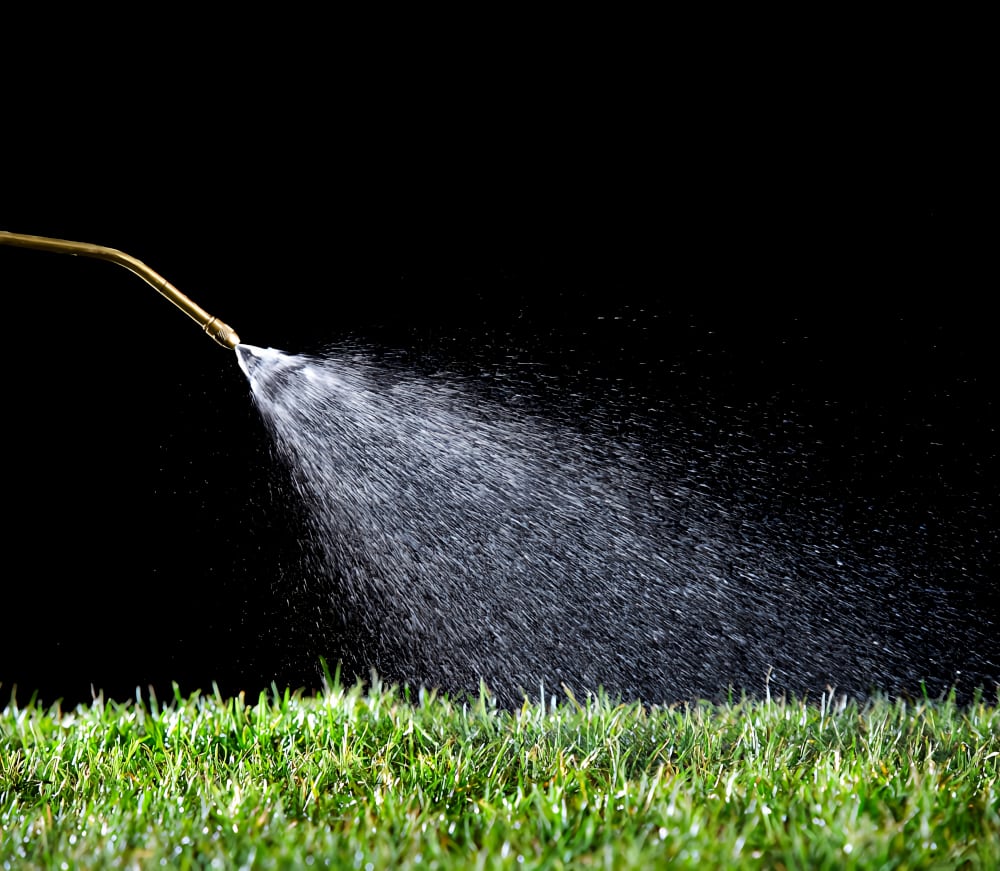
Unger Proposes a Change in Rate Structure
Unger said he would bring the issue of water bill restructuring to the HSVPOA Board of Directors. “The way our water rates are structured, you are allowed a certain amount of water usage in the base allowance. Many people are very conscious of this to keep water bills low and focus on not exceeding the base volume allowance.”
When you exceed the base volume allowance for Hot Springs Village water, the additional usage is still calculated at the same rate per unit as the base rate. In other words, while you pay for extra water usage over the base allowance, you are not penalized at a higher cost per unit for additional water usage.
Not Conserving Water Costs Everyone – Not Just the Higher Volume Users
Unger said that this is not, in his opinion, the way Hot Springs Village water bills should be calculated. The extra water usage in the hotter months is generally tied to irrigation, which can be very expensive for the Village. Unger said it is his opinion that the current water rate structure drove the [recent] water plant upgrade to a six million gallon capacity. On any usual day, our [the Village’s water] usage is about two and a half million gallons. You don’t have to upgrade your plant until you hit 90%, which would have been 3.6 [million gallons per day of water usage]. I don’t know what was driving it [the water plant upgrade] if it wasn’t irrigation. Our current use is about 2.5 million gallons [of water] daily,” explained Unger.
If we are in a water conservation environment, this may prevent or at least delay a need for more water plant capacity. Villagers’ decisions to irrigate their lawns could drive a need for future water plant expansion.
Unger Recommends an Inverted Block Rate Structure for Water Bills
The Public Services Director said, “I will recommend an inverted block rate structure to the Board,” An inverted block rate is also known as an inclining block rate. This is the structural form most frequently associated with a conservation-oriented water rate.
The diagram below is for illustrative purposes only and has rates lower than we pay today. This is an example of how an inverted block rate structure works and is NOT Director Unger’s specific recommendation.
Illustration of an Inverted Block Rate Structure
(This is NOT the HSV Proposed Rate Structure.)
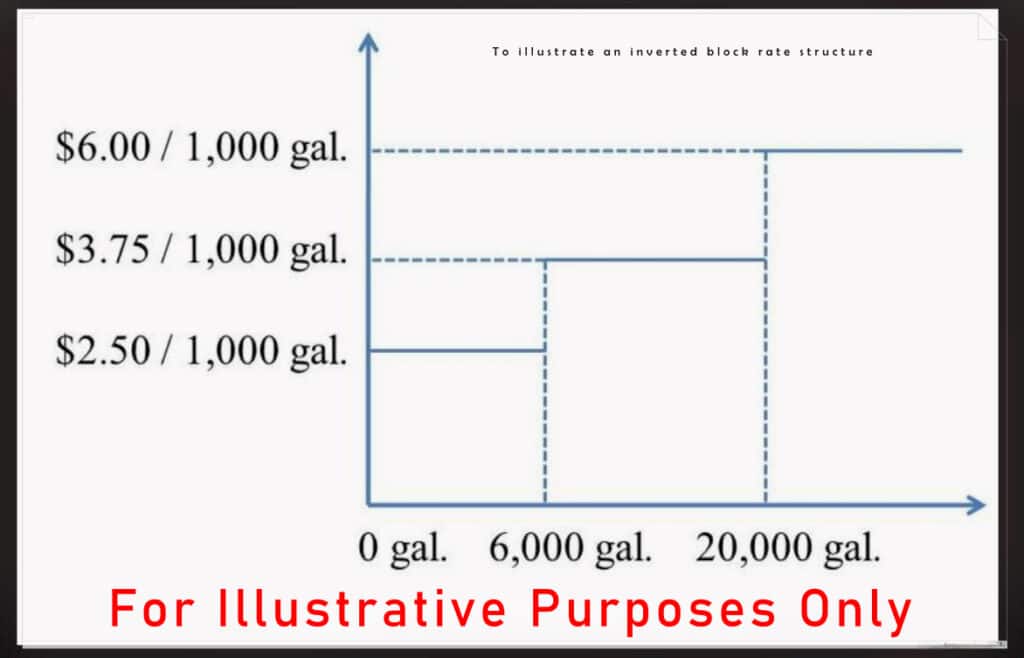
“The goal of an inverted rate block structure is to make the [water] rates more progressive, which I think needs to happen in the Village on everything. If you use it, you pay for it. This keeps the base rate in control and fairly low for those who [conserve water] instead of raising all the rates.”
HSVPOA Public Services Director, Ken Unger
It is Your Choice to Conserve Water Usage
Unger said, “The goal is if you want to use the water – Great! Use it! But you are going to pay for it. Or you stop using [as much water], and you conserve. There is no incentive to have somebody control their irrigation at the [current] water rates. It is not expensive; even if they are upset by their summer water bill rising, we don’t charge much extra for exceeding water usage over the base amount.”
Water Supply Needs to Be Sufficient In Case of Fire
Unger asked, “Should the Village be in more of a water conservation environment so we don’t have to increase the water plant capacity for fire flow issues (due to increased water usage in hotter months)?” Providing water for fire protection means that a water provider must consider fire flow requirements.
When Can We Expect Changes and or Increases?
Some proposed increases in HSV water bills will be based on the requirements to fund needed improvements through bonding, but the proposed inverted rate block structure changes could happen soon. As we implement the proposed necessary utility infrastructure programs,* rate increases will be tied to these improvements and the related bonding. But we can still expect our rates to increase, regardless of bonding. Unger anticipates an increase in the base usage rate, also.
Unger Believes in Paying For What You Use
Unger feels that the rates/fees for everything in the Village should cover the real supply cost. “I believe this is true for everything you do in the Village. Shouldn’t the POA charge what it costs to support your actions?” asked Unger.
“It is great if you want to use things, but if this is driving [the POA] to spend millions of dollars, then you should pay for your usage.”
HSVPOA Public Services Director, Ken Unger
Director Unger said it would be up to the Board of Directors whether all the proposed changes are implemented, but we should expect utility rate increases. Unger also shared, “We are subsidizing water service by around $170,000 this year. We should make enough from a water/sewer environment to support the needed infrastructure work. State law requires this. This is not even in our control. We need to find ways to deal with this. We either raise all the rates or make users of greater quantities of water pay more per unit for the extra usage so we can keep the base usage cost lower. These are the only two options I am aware of.”
Let us know what you think in the comment section below.
*UPDATE ON PROPOSED HSV WASTEWATER SYSTEM UPGRADE
Contact Information for Public Services Director
Ken Unger
Director Public Services
Hot Springs Village
501-226-9609
Kunger@hsvpoa.org
We’d love to have you join our private Property Owners’ Facebook Group. Click here to join.
Click here to visit the Hot Springs Village POA Official Facebook Page.
By Cheryl Dowden
Edited 09/17/23 2:44 p.m. to clarify the Inverted Block Rate Structure diagram.

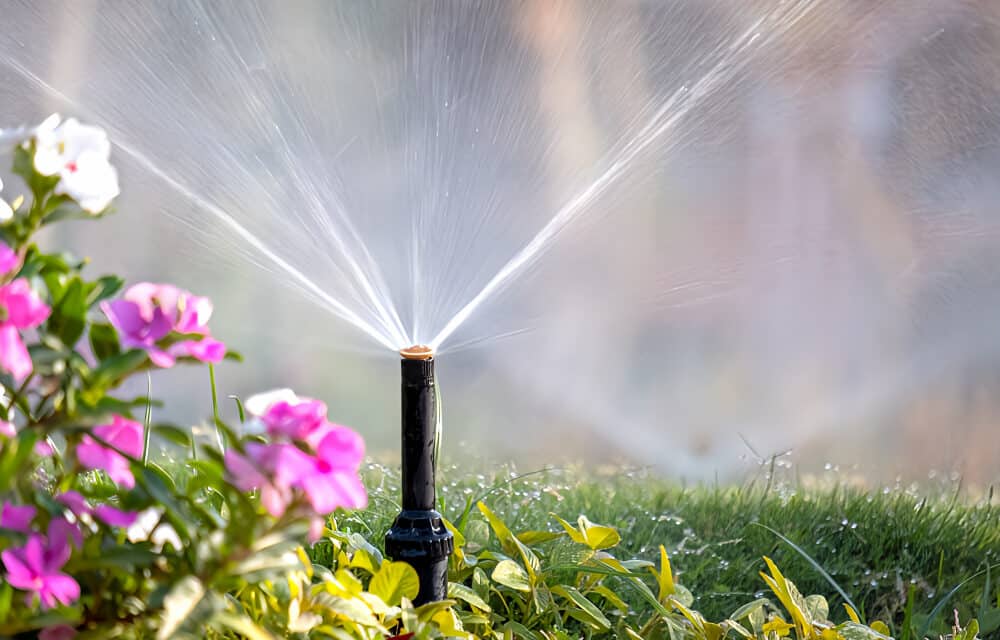
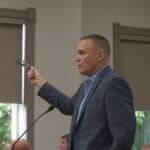
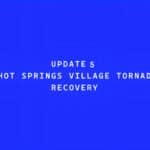
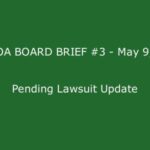
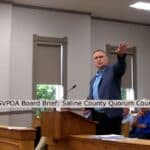


The same base rate allocation of water for large homes and small homes seems off to me. Shouldn’t the base allocation be based on the size of the home and the number of occupants?
If you can scale the pricing of the water usage, you can also scale the size of the base water allocation. When the base rate reflects the size of the home – which has increased over the years – I would support Mr. Unger’s proposal.
People should also keep in mind that we don’t actually pay anything for the water we bring into the village. It comes to us free thanks to the Middle Fork of the Saline River. It’s not like we are paying for it like many far west cities do or have to build massive aqueducts like California and steal it from other states. And whatever happened to the massive water plant upgrade of 10 years or so ago which was implemented with bond money and in the view of many wasn’t even needed? Or how about this idea: Let all the golf courses run a stub line to all the adjacent homes/lots so they can use that water to irrigate their yards and flower beds. That golf course water comes free also and isn’t run through the treatment plant. Doing that would be similar to all those lake front homes who get free water from the lakes for their irrigation.
As I recall, just a few years ago our loss rate from water main breaks and other infrastructure neglect issues was something like 35% whereas acceptable industry standard was less than 10%. Has this actually been fixed? I seem to hear about line breaks almost every week along with boil water notices. Before we start jacking up water user rates we need to get a handle on those types of issues. Wasn’t the recent jacking up of assessments supposed to go towards fixing those issues? When is that problem going to be under control ?
Yes, the recent assessment increase was supposed to go towards the deferred infrastructure repairs and that is exactly where it has been going. This includes roads, water, sewer, buildings, etc. The leakage is being addressed. It is a very expensive process to hunt down and repair all of the leaks, but Director Unger is working on this diligently and methodically. As you are aware, the system is over 50 years old in places and Hot Springs Village has miles and miles of piping, so the correction is a massive undertaking. He has already addressed a number of areas. This is documented.
Why are those of us who do not live on a lake penalized for watering lawns and gardens but lake owners get free water?
If we are really worried about subsidizing the water plant operating cost by only $170,000 then why don’t we fix the chronic golf program losses which run between $500,000 and $2,000,000 every year and have done so for the last 10-15 years. Perhaps Mr Unger should take over the golf department.
Any way the POA can increase funds to pay their salaries right. How about having our bills adjusted with inflation just like you raised wages to “keep good help”
Anyone that has had or has a R/V knows that if u go lightly on the toilet urine flush that YOU CAN CONSERVE ALOT of water …….TRY IT & FIND OUT , WE DO !!!
My observation, If one of the reasons for the progressive rate structure is to increase revenue to cover upgrades, maintenance and comply with the law, it seems to me that encouraging conservation will defeat the purpose. If we use less water there will be less revenue, if there is less revenue then the Water Utility will have to figure out how to get more revenue for maintenance and compliance with the law. Perhaps then, there should be an additional long range proposal for additional revenue to go along with the progressive block rate proposal. At least, I would like to see included in Mr. Unger’s proposal the long term (at least 10yr) revenue and water usage expectations factoring in the conservation of water he is hoping will happen.
The water rate structure where we moved from was based on our winter quarter usage. (We were billed quarterly.) For the other 3 quarters, we were allowed 125% of the winter quarter usage before overage rates kicked in. That always gave us enough water to have a nice vegetable garden (mulched heavily to retain water), and I don’t think we ever had to pay a higher rate for using more than 125% of our winter quarter usage. Overage rates followed an inverted rate block like Mr. Unger is proposing.
Pay for what you use seems to be very fair.
If you are going to raise rates, would you also consider raising the base amount of water we are charged for regardless of how much we use? This would help those who are trying to conserve but are always right at the edge of the base amount. It would also make those who are always using more water pay for the amount you consider as “non-conserving.” This might make the proposal more palatable to everyone.
I don’t like the “inverted block rate structure”!!! There are fixed costs associated with running and maintaining the HSV water system. Every household will use water from that system, and those costs should be equally share by every household. The fixed costs should be covered by the base rate. Rates for usage above the base volume should be based on additional costs incurred to provide the additional volume of water.
I only use about 2500 gallons of the 5000 gallon allotment …why should i pay for water I don’t use ?
If you are going to use an exhibit, base it on the current/proposed rates. Fees based on usage are generally thought to be the best way to bill users but only if the base amount is reasonable. If the base amount is so low that everyone regardless of conservation exceeds the base, the incentive to conserve is “watered down”. If the utilities department really wants to provide fairness, those who use less than the minimum should be either allowed to roll the unused amount forward for future billings and if the accumulated unused amount exceeds a full billing allotment, the see should get a “free” billing period, or the current bill should be reduced on a pro rated basis.
Punishment for over use without reward for conservation is the typical government model.
Woody, you made some interesting points. The exhibit was clearly marked “For illustrative purposes only.” I am sorry that you missed that. – Cheryl Dowden
I left a reply but was kicked out
You have a comment. It sometimes takes me a little bit to approve comments. We have been spammed before, so all comments must be approved and I have approved your comment. Thanks for commenting. – Cheryl Dowden
Yes… I agree on water usage philosophy of progressive rates. The fear I have is that since our last P.O.A dues increases over the last 3 years , the unexpected inflationary creep in was not calculated in today’s costs I believe that Villagers will not in think of further increases without a revolt of some kind.; moreover, will be picked up elsewhere. I reason I think this is because of our experiences living & working in Parma, Ohio. While there over 40 years taxes millage climbed greater than inflation . When compared with outside suburbs Parma was mismanaged to a point that residents ( 90,000) lost trust and voted down all further increases. As a result the equalizer was the triple of sewage rate to water usage rates. Will this happen here ? I`am hoping not. Inflation is a stealth destroyer of wealth, if not dealt head-on it will spread if city management passes costs elsewhere . This cycle never ending.
Kudos to Mr. Unger for this proposal. Going into the future we all need to be more cognizant of our water usage. Lawns are one of the biggest wastes of our good water. Please consider replacing water thirsty plants with those that are more drought tolerant. Natives are a great choice. Consider replacing a thirsty lawn with gravel and beautiful rocks. We have plenty here!
I’m totally for Mr. Unger’s inverted rate block structure that he has proposed to help reduce water rates in the Village. I believe current rates for water usage are very high for the amount of water usage allowed before you even go up to the next higher rate category over 5000 gallons usage. It’s just me and my wife in our 60’s utilizing our water usage in our home, we don’t irrigate our yard ever, even though we would like too to keep our lawn healthy and green, we just rely on rain water to hopefully be enough to allow it to survive, because I can’t imagine how much higher our water bill would be. We only take showers/baths about every other day or so and usually share the bath water to conserve, but even with this much conservation, we seem to get close or exceed the 5000 gallon base amount of usage allowed and we end up having to pay an additional amount for those gallons over the 5000 base limit. I hope Mr. Unger’s inverted rate block structure as pictured above will be adopted for use by the POA immediately, thank you, Steven and Jenny Kates
I agree with Mr Unger that we use too much water for lawns/plants and I think increased water rates will help pay for the water plant upgrade. But there’s another way that will help reduce water usage–create an non-permit system to replace high water dependent plants with native plants that need less water. By making it easier and less expensive for property owners to replace these high water dependent plants, more water will be available in case of emergencies.
Many cities in the southwest U.S. require low water vegetation to conserve water. These lawns not only save water but they’re also attractive and low maintenance with fewer weeds. It’s worked in other areas, there’s no reason it can’t work in HSV.